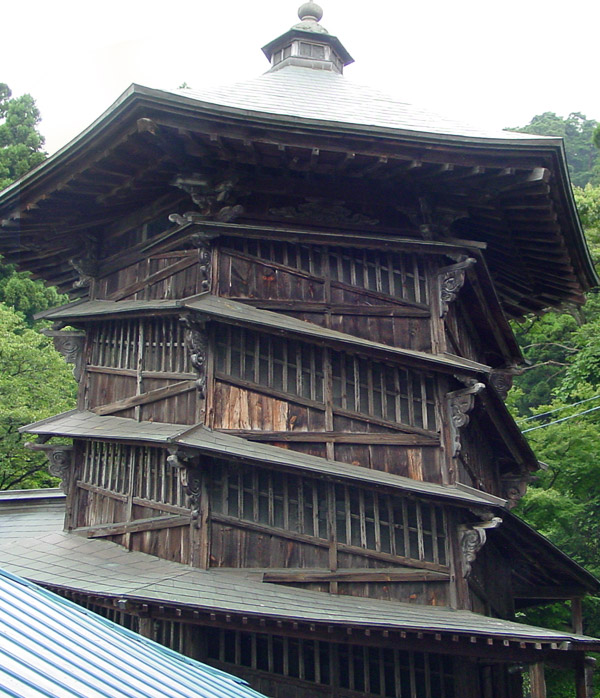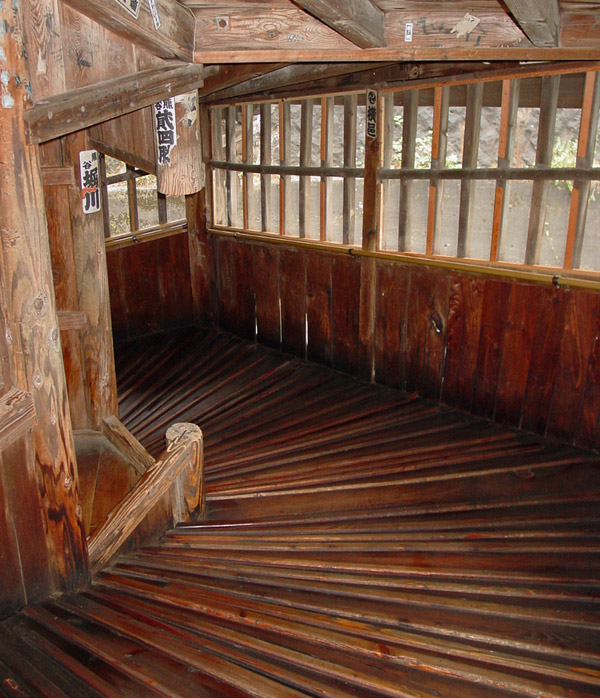|
||
 |
||


Seisouji Sazaedou 正宗寺 栄螺堂 (Fukushima)
(C)2001 Japanese Architecture and Art Net Users System. No reproduction or republication without written permission.
掲載のテキスト・写真・イラストなど、全てのコンテンツの無断複製・転載を禁じます。
|
||||||
| sazaedou 栄螺堂 | ||||||
| KEY WORD : architecture / buildings & structures | ||||||
| Also called sansoudou or sasaidou 三匝堂. An hexagonal Buddhist hall constructed with two internal, circuitous routes meant to represent a pilgrimage route. Devotees to Buddhism could follow the route inside the building in lieu of making more lengthy pilgrimages from one temple to another. Shapes of miniature shrines line the spiral slopes. Temples of this type were built in the Kantou 関東 and southern part of Touhoku 東北 regions. These little shrines originally contained thirty-three images of *Kannon 観音. During the anti-Buddhist movement, they were removed. An excellent example is the Sazaedou dated 1796 still extant at Seisouji 正宗寺 in Fukushima prefecture. The Sazaedou is a pagoda-like structure, hexagonal in shape, and has a step canopy with undulating bargeboard *karahafu 唐破風, over the entrance. The pyramidal roof is covered with copper sheeting. On the first story, one segment of the hexagon is 4.14m wide. The roughly hewn, seven-sided pillars have an inward incline so that the interior of the top story is smaller. Pilgrims usually made three ascents and three descents. There are two inclined walkways, one for ascent, the other for descent. At the top is a bridge for crossing over to the descending slope. The two walkways total three spirals, going up equals one and a half and going down, one and a half. Therefore, it was originally known as a sansoudou or three rounds hall. This structure was conceived by a priest called Ikudou 部堂, for the purpose of enshrining 33 Kannon images, that were arranged around the center of the structure between the upward and downward slopes. Holes into which to drop offerings were set in front of each statue. The offerings could be easily gathered because the money slid down a gutter to a collection point. The exterior reflects the interior arrangement clearly . The ideas and motivation for creating such buildings, so unlike the traditional styles up to the 18c, came from exposure to European books dealing particularly with perspective and realism especially. One such book, "Representations of Practical Perspective" by the Englishman, Joseph Mochson (1617-1700), was published in London in 1670. Other imported books also discussed the use of double spiral staircases and became known to some Japanese scholars such as Satake Shozan 佐竹曙山 (d.1785), a scholar of Dutch, in whose sketch book was found a drawing of spiral stairs. It is confirmed that Shozan copied his drawing from #35 in Mochson's book on perspective. | ||||||

 Seisouji Sazaedou 正宗寺 栄螺堂 (Fukushima) |
||||||
| REFERENCES: | ||||||
| EXTERNAL LINKS: | ||||||
| NOTES: | ||||||
(C)2001 Japanese Architecture and Art Net Users System. No reproduction or republication without written permission. 掲載のテキスト・写真・イラストなど、全てのコンテンツの無断複製・転載を禁じます。 |
||||||